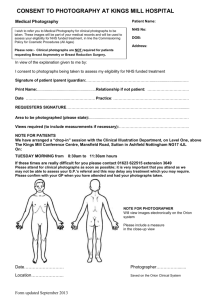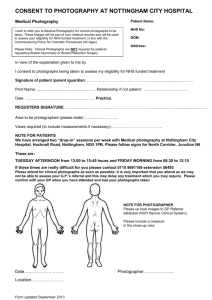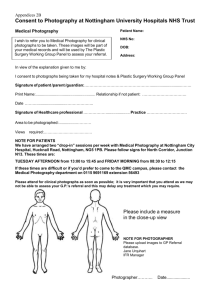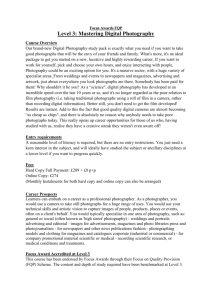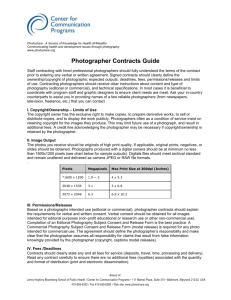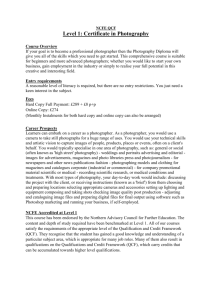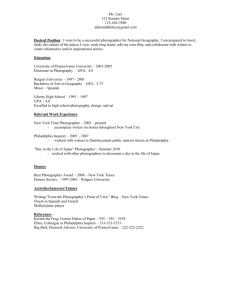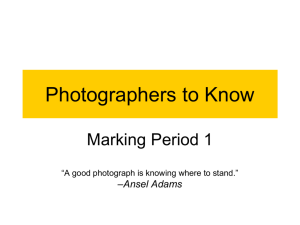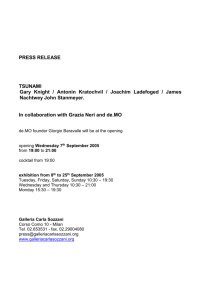Famous Photographers List
advertisement
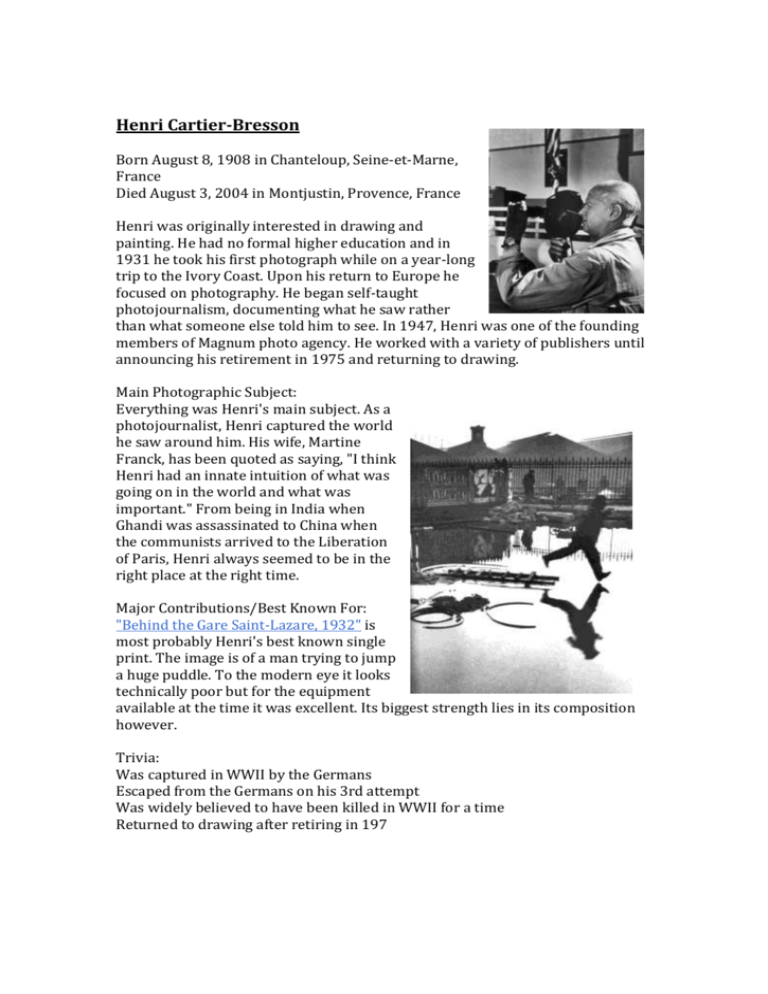
Henri Cartier-Bresson Born August 8, 1908 in Chanteloup, Seine-et-Marne, France Died August 3, 2004 in Montjustin, Provence, France Henri was originally interested in drawing and painting. He had no formal higher education and in 1931 he took his first photograph while on a year-long trip to the Ivory Coast. Upon his return to Europe he focused on photography. He began self-taught photojournalism, documenting what he saw rather than what someone else told him to see. In 1947, Henri was one of the founding members of Magnum photo agency. He worked with a variety of publishers until announcing his retirement in 1975 and returning to drawing. Main Photographic Subject: Everything was Henri's main subject. As a photojournalist, Henri captured the world he saw around him. His wife, Martine Franck, has been quoted as saying, "I think Henri had an innate intuition of what was going on in the world and what was important." From being in India when Ghandi was assassinated to China when the communists arrived to the Liberation of Paris, Henri always seemed to be in the right place at the right time. Major Contributions/Best Known For: "Behind the Gare Saint-Lazare, 1932" is most probably Henri's best known single print. The image is of a man trying to jump a huge puddle. To the modern eye it looks technically poor but for the equipment available at the time it was excellent. Its biggest strength lies in its composition however. Trivia: Was captured in WWII by the Germans Escaped from the Germans on his 3rd attempt Was widely believed to have been killed in WWII for a time Returned to drawing after retiring in 197 Ansel Adams (1902-1984) Ansel Adams is very likely the single most recognized photographer by name. A combination of timing and location led to his fame. In the early nineteenth century travel took much longer than today so Adams’ sweeping views of the stunning Western United States landscapes were unprecedented views to the vast majority of Americans. Beginnings Ansel Adams was born February 20, 1902 in San Francisco, California (Turnage, n.d.). Adams parents, Charles Hitchcock Adams and Olive Bray were around forty years old when Adams was born (very old for the times) (Turnage, n.d.). By the time Adams was 12, he obviously did not “fit in” at school and Adams’ father took the bold step of bringing the boy home for homeschooling (Deyo, 2002). Beyond English literature and algebra, Adams also studied the piano and spent a full year exploring the Panama-Pacific International Exposition which was a collection of exhibits based around the opening of the Panama Canal (Deyo, 2002). The Photographer Emerges In 1916 the Adams family took a trip to Yosemite National Park during which young Ansel was given a Kodak Brownie (Deyo, 2002). A few years later, in 1919, Adams joined the Sierra Club which was later responsible for the his first published works. Like many photographers today, Adams had his first published work in a club newsletter (Turnage, n.d.). It was Sierra Club trips during which Adams began to realize that photography instead of music was a possible career (Turnage, n.d.). In 1932 Adams joined photographers, Willard Van Dyke, Imogen Cunningham, Edward Weston, Henry Swift, Sonya Noskowiak, and Jon Paul Edwards in starting the photographic group f/64 (Hostetler, 2004). This group was dedicated to photography that looked like photography and showed the world without glossing over bits and pieces of it (Hostetler, 2004). The name f/64 came from the theoretical smallest aperture possible on a camera lens that allowed for the largest depth of field to show as much of an image as possible in sharp focus. Body of Works While Adams is probably best known for his images of the Sierra Nevadas and Yosemite he had a much wider body of work. Working with Dorothea Lange, Adams created various image sets for Time Magazine and others (Deyo, 2002). The subjects of these images were diverse as water rights struggles to the Mormons of Utah (Deyo, 2002). Adams also recorded the Japanese American interment camps from World War II (zpub, n.d.). Technical Photography In addition to the photographs themselves, Adams contributed to the growing field of photography in his development of the “zone system” relating to exposure and development (Turnage, n.d.) before computerized light meters and developing techniques. Adams was also a consultant for companies such as Polaroid and Hasselblad (Turnage, n.d.). Berenice Abbott Known for: photographs of New York, portraits of notable artists including James Joyce, promoting work of French photographer Eugene Atget Dates: July 17, 1898 - December 9, 1991 Occupation: photographer and sculptor About Berenice Abbott: Berenice Abbott was born in Springfield, Ohio, in 1898, and was raised by her mother, with little contact with her father and other siblings. She studied at Ohio State University and then became involved in the art scene of Greenwich Village, New York. She studied art in New York, Berlin, and Paris. Moving to Europe in 1921 to pursue her art, she studied with Antoine Bourdelle, Man Ray, and Eugene Atget. She worked to bring Atget's work to public attention, in Paris and later in New York. Berenice Abbott worked as an independent photographer in New York 19291968, including teaching from 1934-1968. As Atget had deliberately documented the changes in the city of Paris through photography, Abbott took pictures of New York and how it was changing in the 1930s. For a time, she was funded for this project by the Works Project Administration. In the 1940s and 1950s Berenice Abbott began writing about the science of photography, as part of her concern for realism in her field. Berenice Abbott moved to Maine in 1968. Berenice Abbott's companion was Elizabeth McCausland, art historian and critic. Books: Changing New York (1939) (later published as New York in the Thirties (1973) and Berenice Abbott: Changing New York (1998). A Guide to Better Photography (1941, revised 1953) The View Camera Made Simple (1948) The World of Atget (1964) A Portrait of Maine (1968) Berenice Abbott also wrote many articles for magazines, especially photography magazines. Quotes: Photography can never grow up if it imitates some other medium. It has to walk alone; it has to be itself. [about going to Paris] I thought I may as well be poor there as here. Robert Cappa Although he is best known for his war photographs, Robert Capa hated war and openly made his opinion known. In an interview about his career as a photographer he commented: “To me war is like an aging actress—more and more dangerous and less and less photogenic." He may not have liked the subject that he covered, but to this day he is credited with some of the greatest wartime shots of all time. His Early Days Robert Capa was born in Budapest, Hungary in 1913. His birth name however was not Robert Capa. He was born Andrei Friedmann. Times were tough in Hungary, so he ventured to Berlin where he obtained a darkroom apprenticeship with a Berlin photo agency. He realized early on that he enjoyed taking pictures more than developing them, so he made a point of taking as many photographs as he could during his time off. It was one of these shots that helped him on his way to a career as a photographer. He took some exclusive shots of Leon Trotsky that earned him some instant recognition. Moving On When Hitler gained control Andrei (Capa) decided to move on to Paris. He had met and fallen in love with a Polish woman named Gerda Taro. He tried to make his living as a freelance photographer, but he struggled to earn enough to survive. A Brilliant Deception The two lovers decided they had to do something to increase their income so they hatched a brilliant plan. They created a fictional American photographer who they claimed was visiting France and they named him Robert Capa. Gerda would be his secretary and sales representative and Andrei his darkroom assistant. The American was not only a brilliant photographer, but he was rich and famous, and oh so talented. Andrei took the photographs and Gerda sold them. Credit was given to the fictional Robert Capa. She was even able to command rates that were more than three times the going rate, explaining that he was so rich that paying him any less would be an insult. As expected, their secret got out, but it didn’t matter since by this time his brilliance as a photographer had been discovered. A Famous Photograph The photograph which started his renowned career as a war photographer was of a dying Spanish soldier. With his success came heartbreak when his beloved Gerda, who accompanied him, was killed on the battlefield. With a broken heart he needed to move on to a new location, so Capa ventured to China where he covered the battle of Taierchwang. His photographs were again memorable and further propelled him to fame as a top war photographer. Moving to America When World War II began Capa found himself in America. In 1942 he joined the invasion convoy to North Africa as a photographer for Life Magazine. His next stop would be Sicily, where he accompanied paratroopers and created more magnificent images. One of the most well known events of his life occurred when in 1944 Capa stumbled onto Omaha Beach. With heavy gunfire around him, Capa managed to take four rolls of film under these extremely difficult conditions. Sadly, a mishap in Life Magazine’s London darkroom ruined all but eleven frames of film. The remaining images were published in Life although they did not admit darkroom error and instead represented them as slightly out of focus shots taken by Capa. This did not discourage Capa, who continued as a war photographer seeing the war through to its bitter end photographing the death of one of the last Americans killed in the war. His Foot in the Business World Tired of photographing war he decided to turn his attention to the business world and joined forces with Henri Cartier-Bresson, William Vandivert, David Seymour, and George Rodger in the creation of Magnum Photos. Magnum was the first, and is still the only, international cooperative freelance photographer agency in the world. At this point in his career he decided to start writing, and penned several articles. He also has four photographic books to his credit. War Was In His Blood Although he loved his new business venture, and spent much time promoting it, he still found a special excitement in covering wars. So while in Japan in 1954 promoting a Magnum exhibition a call from Life Magazine sent him back into the trenches. He headed to the Indochina front. Unfortunately this is where his luck ran out. Still clutching his camera Robert Capa lost his life when he stepped on a land mine on a battlefield in Indochina. A Well Deserved Honor A well deserved honor was bestowed upon this brave man and exceptional photographer, when The Overseas Press Club established the Robert Capa Award “for superlative photography requiring exceptional courage and enterprise abroad.” Robert Capa will forever be remembered for his incredible photographs and the unrelenting courage he displayed to get the memorable images that will forever live on. Cindy Sherman Cindy Sherman is considered one of the most respected photographers of the twentieth century. Ironically, the majority of her photos are of herself. The Early Years Born in Glen Ridge New Jersey, Sherman’s family moved to Huntington, Long Island shortly after her birth. She was the youngest of five children. Sherman was not exposed to art or photography as a child. It wasn’t until she got a bit older that she began to recognize her interest in the arts. Although art was not stressed in the Sherman house, her parents were supportive of her decision to attend art school after graduating high school. Her mother did suggest that perhaps she should take some teaching classes to be certain she would get work. Sherman started her study of art at the State University College at Buffalo. A Change of Focus Sherman began her college career focusing on painting until one day when she just decided she didn’t want to do it anymore. She felt as if there was no more she could do artistically and wanted another way to express herself. She felt that she was just copying other people’s art, so she decided that she would use a camera and spend more of her time coming up with tantalizing ideas. It was at this point that she switched her focus to photography. An Important Meeting During her studies at Buffalo Sherman met fellow artist Robert Longo. She would join with Longo and a fellow classmate Charles Clough to form Hallwalls, an independent artists’ space where she and other artists could exhibit their work. Her Career Begins After Sherman graduated from college she picked up and moved to New York City ready to embark on her new art career. She rented a loft in lower Manhattan. This was when she began taking photographs of herself. These photos would come to be known as the Untitled Film Stills and would become her most famous work. The Untitled Film Stills In these images Sherman placed herself in the roles of B-movie actresses. She would dress up in wigs, dresses, and hats taking on the persona of various characters. These would include housewife, prostitute, dancer, actress and women experiencing various emotions. Though they were photographs of her, they weren’t actually self portraits, since she was dressing up as other characters. Sherman would play all of these various characters in front of her lens. Although unconventional Sherman’s reasons for her photos were to show how mistreated women were in society. She was her own vehicle for her commentary on issues of importance such as the role and representation of women in society and the media. This is most likely why she never named the pictures or the subject. She wanted the photos to be depersonalized and even though she posed as the model, she only wanted to represent “every woman.” Sherman worked on this project for three years until she ran out of clichés and moved on. Her First Show Sherman received much acclaim for her work and was given her first solo show at the Kitchen in New York City. In 1981 she was commissioned by the magazine Artform to do a centerfold, but after shooting it the final product was rejected by the publication. After this event Sherman decided to thoroughly change her style and find another subject that was not quite so close to home. In her shots from 1985 to 1989 she appeared in less of her own photos. When she was in the images they were grotesque often strewn with vomit, mold or other vile substances. She found beauty in these images and continued experimenting with doll parts to create these disturbing images. These photos are often referred to as the Disasters and Fairy Tale series. A Change of Venue Sherman moved to Rome to work on her next project which involved placing herself in the roles of famous paintings. She again used the help of prosthetic body parts and dolls to augment her own body. She was surrounded by museums and churches, but instead of visiting them for inspiration she preferred to gain her ideas from books. In 1992 Sherman created a new series of photographs which would shock the critics. These are now referred to as "Sex Pictures." Sherman was completely absent from these photos. She used prosthetic genitalia, both male and female, taking extreme close ups. The purpose of these photos were to shock the viewer and she managed to do so. Her Directorial Debut She has also found another interest in her life, motion pictures. Her directorial debut came in 1997 with her movie, Office Killer which starred Jeanne Tripplehorn. She managed to step in front of the camera for a cameo role in John Waters’ 1998 movie Pecker. Since Sherman gained recognition at an early age, her work has grown in value over the past ten years. The average selling price for one of her photographs was estimated in 1999 at between $20,000 to $50,000. In 1996 the Museum of Modern Art bought a full set of this same series for one million dollars. In 1999 at a Christie’s auction one of the photos from her Film Stills collection sold for a reported $190,000. The California Project In Sherman’s recent project she reverted back to using herself as a model. In this series she disguised herself as women from California. Her series included The Personal Trainer, the Ex-Realtor, and the Divorcee. She currently continues on her projects while living in New York City. The Museum of Art will show a complete retrospective of Sherman’s work from the 1970’s on which will include over 170 photographs. Joe Rosenthal Born October 9, 1911 in Washington, DC Died August 20, 2006 in Novato, CA Rosenthal was a son of Russian immigrants in the Great Depression. After high school Rosenthal moved to San Francisco and managed to secure a job with the Newspaper Enterprise Association. A few years later he got work as a photographer and reporter for the San Francisco News. By the time the United States entered WWII, Rosenthal had moved to New York Times-Wide World Photos as chief photographer. It was during WWII that Rosenthal secured his place in photographic history with his image of the flag raising over Iwo Jima. Main Photographic Subject: War photography was Rosenthal's main subject. Although he tried to enlist with both the Army and Navy, he was denied service due his nearsightedness. Determined to serve his country, Rosenthal joined the U.S. Maritime Service and photographed convoys in the Atlantic. After a year in the Maritime Service, Rosenthal returned to the Associated Press (who had purchased New York Times-World Wide Photos). The AP sent Rosenthal to cover battles and their aftermaths in the Pacific area. Some of the locations he photographed were Guam, Peleliu, and Iwo Jima. Major Contributions/Best Known For: Rosenthal is best known for his photograph of the flag raising at Iwo Jima. The flag raising over Iwo Jima was captured on February 23, 1945 and depicts 4 marines lifting a large flag onto a shell-strown hilltop. The original image was in horizontal format but was later cropped, presumably by the AP into a tighter vertical composition. In order to capture the image, Rosenthal had to stand on a sandbag left behind by the Japanese because he was too short to get a good angle for the image from his viewpoint. The flag raising was actually the second flag raised over Iwo Jima when a commander decided to use a larger flag. Awards: 1945 Pulitzer Prize for Photography for the photograph "Flag Raising over Iwo Jima" Controversy: As the photograph of the flag raising over Iwo Jima circulated more widely and became an iconic symbol with the public of the sacrifices and bravery of the United States Armed Forces, a few people began to wonder if the photograph was staged. The accusation was one that would haunt Rosenthal until his death in spite of evidence proving it was not staged by Rosenthal. Dorethea Lang Some of the most profound photographs from the great depression are those which are attributed to famous American Documentary Photographer, Dorothea Lange. Lange was born in 1895 in Hoboken, New Jersey. She was born Dorothea Margaretta Nutzhorn, but dropped her middle name and took on her mother’s maiden name after her father abandoned the family. She contracted polio at the age of 7, which left her with a permanent limp. Lange honed her photographic skills in New York City taking courses and working as an apprentice to several New York Photographers. In 1918 she left New York and made her way to San Francisco where she opened her first portrait studio. In 1920 she married the well known painter, Maynard Dixon with whom she had two boys, Daniel and John. When the Great depression began, Lange pointed her camera on the unemployed and homeless creatures she came upon on the streets. Her photographs gained the attention and respect of the Farm Security Administration, who then used her photographs to chronicle the living conditions of families hired to work in cotton fields and farms in Arizona and California. Her most poignant image is known as “Migrant Mother.” The model is Florence Owens Thompson, a hungry and desperate mother of three who was living on the street with her children. Lange was surprised when she received no resistance from her sad subject. Lange took five photographs of the woman, never asking her any questions about her circumstances or how she ended up where she was. Her model offered her age as 32, and explained that she and her children had been living on frozen vegetables taken from surrounding fields. Her children had also captured and killed some birds that she also used for sustenance. She had then been forced to sell the tires off of her car to buy food. Lange theorized that the lack of resistance to being photographed came from the fact that in some ways Thompson felt these images might help her. In 1935 Lange divorced Dixon and married agricultural economist Paul Schuster Taylor, a professor of Economics at the University of California, Berkeley. Together, with his knowledge of the poverty laden country, and her photographic skills, they documented rural poverty and the exploitation of migrant laborers for the next five years. In 1941, Lange received a Guggenheim Fellowship for excellence in photography, but quickly gave it up to record the forced evacuation of Japanese Americans to relocation camps, while on assignment for the War Relocation Authority. Her most famous images highlighted Manzanar, the first of the permanent internment camps. This was a time in history when free speech was often compromised, and this was the case with these images. The Army impounded these photographs, and refused to allow her further access. Due to this censorship, on the part of the US government, the true impact of Lange’s work was not felt until over thirty years later. In 1972 the Whitney Museum incorporated 27 of her photographs into an exhibit about the Japanese internment. In 1945, Lange became an academic when she accepted a job offered to her by renowned photographer Ansel Adams. Lange became part of the faculty at the first fine art photography department at the California School of Fine Arts. In 1952, Lange co-founded the photographic magazine Aperture, but worked as a freelancer for several other magazines including Life Magazine. Sadly, Lange spent the last two decades of her life in poor health. She suffered severe gastric problems, and a resurgence of the Polio that had left her limping. On October 11, 1965 Lange died of esophageal cancer at age 70. Even after her death Lange was not forgotten. In 2008 California Governor Arnold Schwarzenegger, and his wife Maria Shriver, announced Lange’s induction into the California Hall of Fame, part of The California Museum for History, Women and the Arts. Annie Leibovitz Born October 2, 1949 in Westbury, CT Annie Leibovitz was born Anna-Lou Leibovitz to Sam and Marilyn Leibovitz. As Sam was in the Air Force the family moved often. It was during a posting to the Philippines during the time of the Vietnam War that Annie first became involved with photography as a hobby thanks to the base's darkroom. In 1970 Annie contacted the founding editor of Rolling Stone, Jann Wenner, about a job. Wenner was impressed by the portfolio Annie showed her and assigned her to photograph John Lennon. Annie's career continued with Vanity Fair and she continues to focus on celebrities. Celebrity Portraiture: Annie's first widely published photo was the January 12, 1971 cover image for Rolling Stone. Her career has centered around celebrity portraiture for various magazines and special projects. Major Contributions/Best Known For: One of Annie's best known photo is the 1981 Rolling Stone cover image of a nude John Lennon curled around a clothed Yoko Ono. The image was taken just hours before John Lennon was murdered on December 8, 1980. More recently Annie has been in the news for the Miley Cyrus photograph and a lawsuit over unpaid debt. Controversy: In June 2008 Annie Leibovitz photographed Miley Cyrus and her father for Vanity fair. Leaked photos had caused a firestorm. The initial outrage was over a waistup portrait of Miley in which she appears to be topless except for a sheet she is holding to her chest. Parents across the US objected loudly to the "sexy" image of the star of the "Hannah Montana" television show. However, that image was quickly sidelined when the lead photo for the article was released. The image is of Billy Ray with Miley reclining across his lap. Again uproar ensued over whether it was an "appropriate" image for a child and parent. James Nachtwey "I have been a witness, and these pictures are my testimony. The events I have recorded should not be forgotten and must not be repeated." These meaningful words were spoken by one of the top wartime photographers, James Nachtwey. His Beginnings James Nachtwey was born in Syracuse New York on March 14, 1948. Nachtwey spent much of his youth in Massachusetts and is a graduate of Dartmouth College, with a degree in art history and political science. Nachtwey credits his exposure to photos taken during the Vietnam War and the American Civil Rights movement as the reason he decided to pursue a photographic career. Nachtwey set out to teach himself photography while working various jobs as a Merchant Marine, assistant news editor and truck driver. Nachtwey decided to focus on photojournalism. His Photographic Career Begins In 1976 Nachtwey started working as a newspaper photographer in New Mexico at the Albuquerque Jorunal. Four years later he moved to New York to begin a career as a freelance magazine photographer. One of his first foreign assignments was to cover the civil strife occurring in Northern Ireland during the IRA hunger strike. After his first taste of news photography Nachtwey decided to dedicate his career to documenting social issues, wars and political conflicts. This line of work lead him to numerous war torn nations including; El Salvador, Afghanistan, Guatema, Nicaragua, Lebanon, South Korea, Rwanda and Thailand, just to name a few. No Family Life Nachtwey decided early on that he would dedicate his life to his work. This meant that there would be no marriage or family, since he knew his career was a dangerous one and wanted to be able to dedicate all of his energy to covering wars without a pull from a family waiting at home for his safe return. Nachtwey also felt that he could not live the contradiction of photographing a starving child and then returning home to a healthy well fed child of his own. As a result of his dedication, there are few historical events which took place in the past thirty years that Nachtwey has not been present to chronicle through his photographs. He was in New York on September 11, 2001 during the attacks on the World Trade Center and is noted for some of the most recognizable photos that came out of this tragic event. His Honors His awards are almost too numerous to list, including winning Magazine Photographer of the Year for seven years, The Robert Capa Gold Medal, The Alfred Eisenstaedt Award, The Canon Photo Essayist award, and the W. Eugene Smith Memorial Grant in Humanistic Photography. He also holds the distinction of being a Fellow of the Royal Photographic Society and has an honorary doctorate of fine arts from the Massachusetts College of art. These are not even a complete list of the awards he has received for his prestigious career in photojournalism. A Life Threatening Injury Photography of this type has always been dangerous, and Nachtwey has received numerous injuries during his career. His most serious one occurred during his extensive coverage of the US invasion of Iraq. This is where he received his first combat related injury. He and Time Correspondent Michael Weisskopf were riding in the back of a humvee with the US Army “Tomb Raiders” Survey Platoon when an insurgent threw a grenade into the vehicle. Weisskopf took swift action grabbing the grenade and attempting to throw it out of the Humvee. Unfortunately, before he completed the action the grenade exploded in his hand injuring two soldiers and the two Times correspondents. In his inexorable spirit Nachtwey managed to take several photographs of medic Billie Grimes treating Weisskopf before passing out himself. Both Times correspondents were airlifted to Germany and then to U.S. hospitals. Nachtwey managed to recover sufficiently to return overseas to document the tsunami in Southeast Asia. His Work Continues In 1999 Nachtwey published his book, Inferno, which included 382 photographs made during the past decade. This is Nachtwey’s record of the terrible costs of 20th century conflict and disaster all crammed into 480 pages. In 2001, a documentary entitled War Photographer was released which highlighted Nachtwey and his career as a war photographer. This documentary received an Academy Award nomination for best documentary film. In 2007 Nachtwey was one of three winners of the TED prize, receiving $100,000 and “one world changing wish.” Results of this work include coverage of the problem of extensively drug-resistant tuberculosis, a disease caused by bacteria that are resistant to the most effective anti-TB drugs. This disease afflicts one in three people in the world and Nachtwey took up the cause to inform the world of this terrible affliction. This is not the only life threatening disease that Nachtwey has taken up as a cause. In 2008, he exhibited a series of original photographs at Le Laboratoire in Paris, France. The show was entitled “Struggle for Life,” which documented the human toll of TB and AIDS. The text that accompanied the exhibit was by Dr. Anne Goldfield with whom he began working in Cambodia in 2003. The exhibit included photos taken in Thailand, Africa and Siberia. The Anti-war Wartime Photographer Although James Nachtwey has spent most of his career photographing war he considers himself an anti-war photographer. Living in the midst of wars and natural disasters has taken its toll on Nachtwey. Nevertheless, he continues working because of his strong belief that his photographs can make a difference. Nachtwey, convinced of the effect his pictures have on viewers, has never stopped hoping to fight the horrors of war, hunger and poverty through his work.
